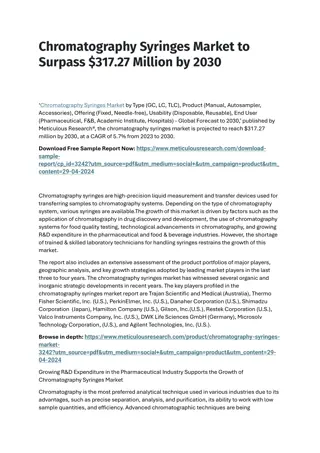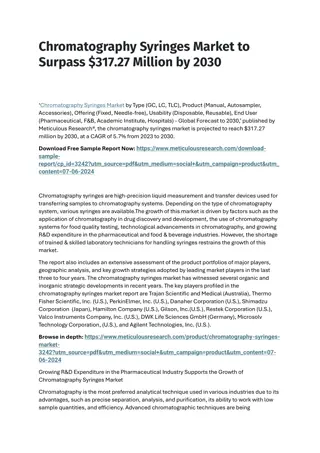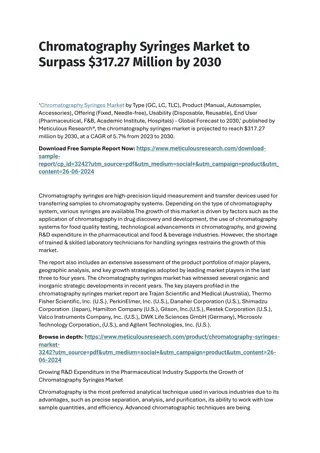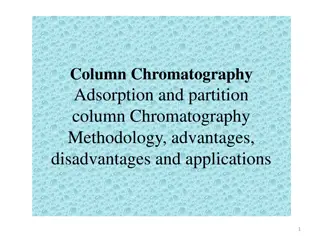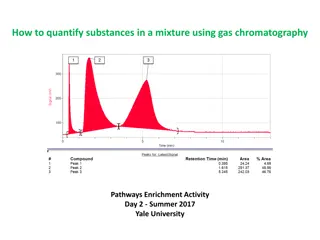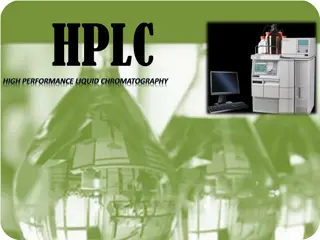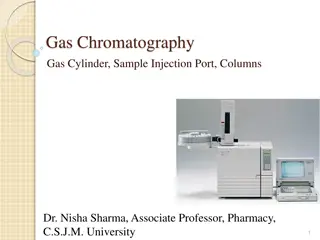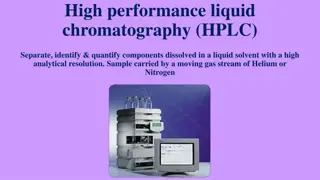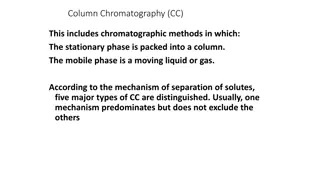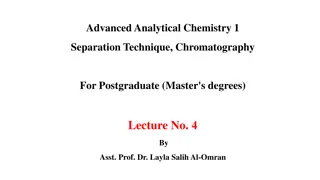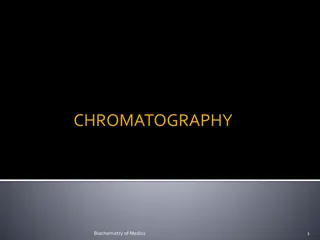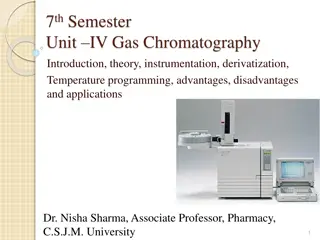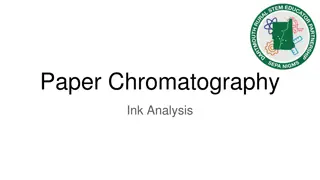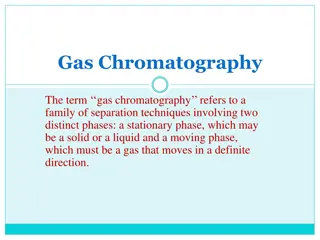An Overview of High Performance Liquid Chromatography (HPLC)
High Performance Liquid Chromatography (HPLC) is a powerful analytical technique used for separating and identifying compounds in a mixture. It involves a mobile phase and a stationary phase to achieve separation based on different physicochemical properties. The mobile phase plays a crucial role in the process by solvating analyte molecules and facilitating their movement. Common solvents like methanol, acetonitrile, tetrahydrofuran, and water are utilized in reverse-phase HPLC. The choice of mobile phase solvent is essential for optimizing separation efficiency based on the polarity index of the solvent.
Download Presentation

Please find below an Image/Link to download the presentation.
The content on the website is provided AS IS for your information and personal use only. It may not be sold, licensed, or shared on other websites without obtaining consent from the author. Download presentation by click this link. If you encounter any issues during the download, it is possible that the publisher has removed the file from their server.
E N D
Presentation Transcript
HIGH PERFORMANCE LIQUID CHROMATOGRAPHY (HPLC) What is HPLC? What is HPLC? Types of Separations Types of Separations Columns and Stationary Phases Columns and Stationary Phases Mobile Phases and Their Role in Separations Mobile Phases and Their Role in Separations Injection in HPLC Injection in HPLC Detection in HPLC Detection in HPLC Variations on Traditional HPLC Variations on Traditional HPLC Ion Chromatography Ion Chromatography Size Exclusion Chromatography Size Exclusion Chromatography
THE MOBILE PHASE IN HPLC... Must do the following: Must do the following: solvate the analyte molecules and the solvent they are in solvate the analyte molecules and the solvent they are in be suitable for the analyte to transfer back and forth be suitable for the analyte to transfer back and forth between during the separation process between during the separation process Must be: Must be: compatible with the instrument (pumps, seals, fittings, compatible with the instrument (pumps, seals, fittings, detector, etc) detector, etc) compatible with the stationary phase compatible with the stationary phase readily available (often use liters/day) readily available (often use liters/day) of adequate purity of adequate purity spectroscopic and trace spectroscopic and trace- -composition usually! composition usually! Not too compressible (causes pump/flow problems) Not too compressible (causes pump/flow problems) Free of gases (which cause compressibility problems) Free of gases (which cause compressibility problems)
COMMON REVERSE PHASE SOLVENTS Methanol CH3OH Acetonitrile CH3 OCN Tetrahydrofuran Water H2O
POLARITY INDEX FOR MOBILE PHASES.. The polarity index is a measure of the relative polarity of a solvent. It is The polarity index is a measure of the relative polarity of a solvent. It is used for identifying suitable mobile phase solvents. used for identifying suitable mobile phase solvents. The more polar your solvent is, the higher the index. The more polar your solvent is, the higher the index. You want to try to choose a polarity index for your solvent (or solvent You want to try to choose a polarity index for your solvent (or solvent mixture) that optimizes the separation of analytes mixture) that optimizes the separation of analytes usually the index is a starting point usually the index is a starting point the polarity of any mixture of solvents to make a mobile phase can the polarity of any mixture of solvents to make a mobile phase can be modeled to give a theoretical chromatogram be modeled to give a theoretical chromatogram Usually, optimization of solvent composition is experimental Usually, optimization of solvent composition is experimental A similar number is the Eluent Strength (E A similar number is the Eluent Strength (Eo o] ] Increasing eluent strength or polarity index values mean increasing Increasing eluent strength or polarity index values mean increasing solvent polarity. solvent polarity. Remember, the analyte(s) and samples must be mobile phase and Remember, the analyte(s) and samples must be mobile phase and stationary phase compatible! stationary phase compatible!
Polarity of water > ACN > methanol > THF e.g. Water is more polar than methanol thus a weaker solvent in RP HPLC i.e. Water elutes the solute slower than methanol does. Therefore, when the percentage of water in the mobile phase is higher, the retention times are longer.
COLUMNS Heavy wall, glass lined metal tubing or SS tubing, withstand pressure upto 680 atm & chemical action of MP. Interior of tubing smooth with uniform bore dia Straight column preferred Column end- zero void volume, Length- 10-30 cm. Short, fast- 3-8 cm.
HPLC COLUMN HPLC COLUMN Column dimension (size), particle size and pore size, stationary phase Water/Methanol 300oA 5 m C18 4.6 x 250 mm Pore Size Dimension Stationary Phase Particle Size
HPLC Columns Particle size Column ID Sample Load 3 5 mm ng g Analytical 10 Semi-prep Preparative 8 10 mm 1 100 mg 10 30 5 200 mm gram scale An HPLC column consists of a stainless steel tube which is sealed with fittings on both ends. Steel frits in the end fittings keep the packing material in the column. Analytical columns have inner diameters of 1 - 10 mm and lengths of 25 - 250 mm. They are operated at flow rates of 60 l - 5.0 ml/min. In preparative chromatography columns with an inside diameter of 200 mm and a length of 600 mm are used. They are operated at a flow rate of 1750 ml/min. To protect the actual separation column from chemical contamination, a guard column with the same packing material as the separation column is installed.
GUARD COLUMNS OR INLINE FILTERS To the life of analytical columns Inserted ahead of AC Act as physical & chemical filters Short- 5 cm, Contains stationary phase similar to AC Protect AC from contaminants from MP/ from degrading sample inj valves which Results in broadening of solute peaks & degradation of separation of components.
OPTIMIZATION OF COLUMN PERFORMANCE Correct choice of column Correct choice of mobile phase Decision on the type of mobile phase composition constant composition = isocratic varying composition = gradient elution Determination of flow rate should be constant usually it is Decision on heating the column heating HPLC columns
GRADIENT ELUTION In Isocratic elution Sample is injected to column & mobile phase is unchanged thru out the time required for sample components to elute. Single isocratic elution can t separate a complex mix. In reasonable time, with good detectability. Therefore, solvent programming called gradient elution is req. That is changing the mobile phase composition stepwise or continuously during elution. Gradient elution- trial & error Gives max., resolution, sensitivity.
DERIVATIZATION To enhance detectibility by U.V. absorption, fluorescence, electrochemistry. Precolumn derivatization before seperation Derivatized sample is injected After separation post column reaction is done. Eg. If detection sensitivity to 254nm in U.V. absorption is Zero or . Detection can be by attaching to solute a chromophore with absorption at 254nm
Reagents N-succinimidyl 4- Nitrophenyl acetate Reactants Amines/ Amino acids 3,5- Dinitrobenzoyl cl Alcohols, Amines, Phenols Formation of fluorescent derivative Allows sensitive detection of non-fluor. Mol. Exploits selectivity of fluorescence by allowing detection of all compounds with particular fn grps in a sample after derivatization. Eg. 4-Bromomethyl-7-methoxycoumarin -COOH
POST COLUMN REACTION Effluent from HPLC column is mixed with a reagent before it enters the detector. A column filled with glass beads mixes effluent with reagent (added thru T valve) before passes the detector. Post column addition of an alkaline buffer (pH 10.4) 20 fold sensitivity of HPLC analysis for barbiturates. 2ng of drg can be detected bcos at alkaline pH the UV absorption max for barbiturates shifts to longer 240 nm. If simple mobile phase is adjusted to alkaline pH- it dissolves the silica based column packing.





